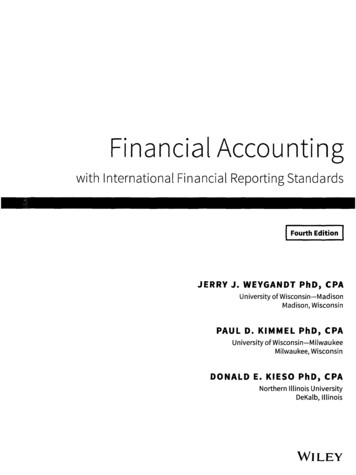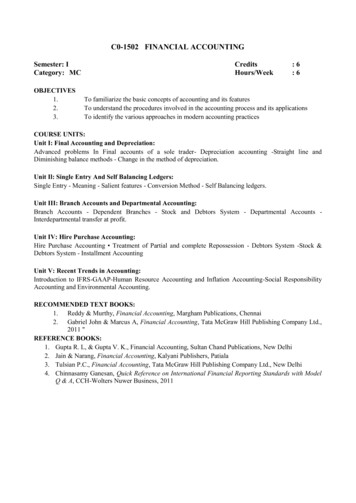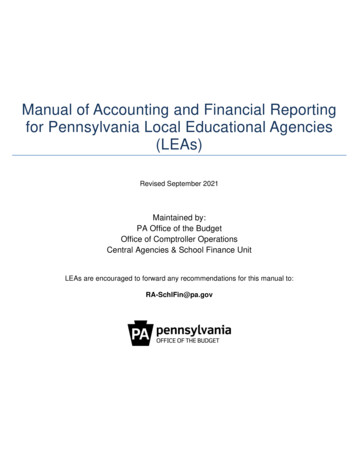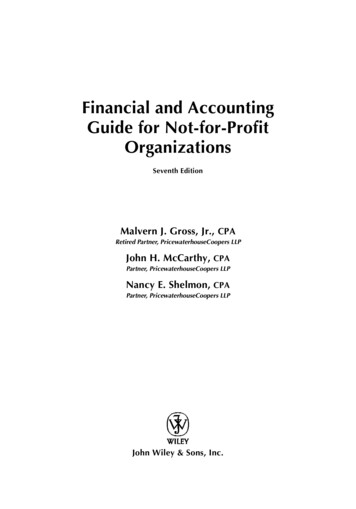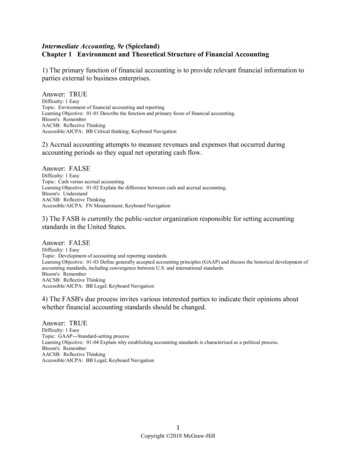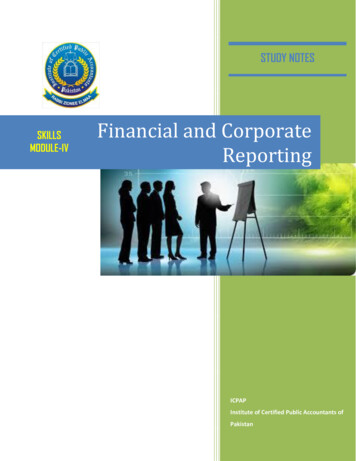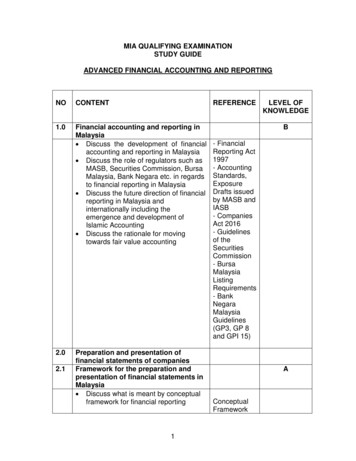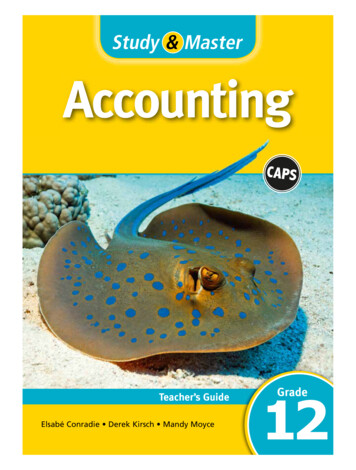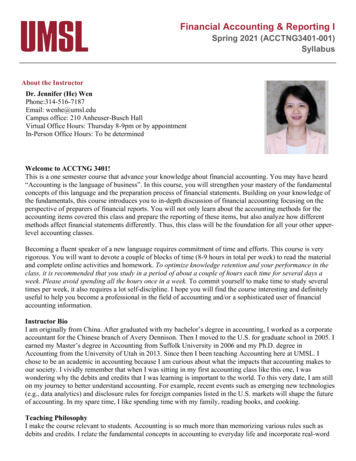
Transcription
Financial Accounting & Reporting ISpring 2021 (ACCTNG3401-001)SyllabusAbout the InstructorDr. Jennifer (He) WenPhone:314-516-7187Email: wenhe@umsl.eduCampus office: 210 Anheuser-Busch HallVirtual Office Hours: Thursday 8-9pm or by appointmentIn-Person Office Hours: To be determinedWelcome to ACCTNG 3401!This is a one semester course that advance your knowledge about financial accounting. You may have heard“Accounting is the language of business”. In this course, you will strengthen your mastery of the fundamentalconcepts of this language and the preparation process of financial statements. Building on your knowledge ofthe fundamentals, this course introduces you to in-depth discussion of financial accounting focusing on theperspective of preparers of financial reports. You will not only learn about the accounting methods for theaccounting items covered this class and prepare the reporting of these items, but also analyze how differentmethods affect financial statements differently. Thus, this class will be the foundation for all your other upperlevel accounting classes.Becoming a fluent speaker of a new language requires commitment of time and efforts. This course is veryrigorous. You will want to devote a couple of blocks of time (8-9 hours in total per week) to read the materialand complete online activities and homework. To optimize knowledge retention and your performance in theclass, it is recommended that you study in a period of about a couple of hours each time for several days aweek. Please avoid spending all the hours once in a week. To commit yourself to make time to study severaltimes per week, it also requires a lot self-discipline. I hope you will find the course interesting and definitelyuseful to help you become a professional in the field of accounting and/or a sophisticated user of financialaccounting information.Instructor BioI am originally from China. After graduated with my bachelor’s degree in accounting, I worked as a corporateaccountant for the Chinese branch of Avery Dennison. Then I moved to the U.S. for graduate school in 2005. Iearned my Master’s degree in Accounting from Suffolk University in 2006 and my Ph.D. degree inAccounting from the University of Utah in 2013. Since then I been teaching Accounting here at UMSL. Ichose to be an academic in accounting because I am curious about what the impacts that accounting makes toour society. I vividly remember that when I was sitting in my first accounting class like this one, I waswondering why the debits and credits that I was learning is important to the world. To this very date, I am stillon my journey to better understand accounting. For example, recent events such as emerging new technologies(e.g., data analytics) and disclosure rules for foreign companies listed in the U.S. markets will shape the futureof accounting. In my spare time, I like spending time with my family, reading books, and cooking.Teaching PhilosophyI make the course relevant to students. Accounting is so much more than memorizing various rules such asdebits and credits. I relate the fundamental concepts in accounting to everyday life and incorporate real-word
Financial Accounting & Reporting ISpring 2021 (ACCTNG3401-001)Syllabusmaterial into class help students see to what they are learning are useful. I aim to create a collaborativeatmosphere in the class. I use discussion board and various assignments to help students to get know and workwith each other. I design the class with an eye to an efficient learning process. I streamline the modules incanvas to take students through the three phases of learning – remember, understand, and apply thefundamental accounting concepts. I emphasize that I care about the students’ success and that I expect them todo their best. I do my best for them and I expect their best in return. I expect timely and quality work from mystudents, and evaluate them based on their performance as fairly as possible.About this CourseCourse PrerequisitesMinimum campus GPA - 2.0, Math 1030, ACCTNG 2410, 57 hours. I will not waive pre-requisites. Makecertain that you have met these requirements.Course MaterialsTextbook (electronic copy via Auto-access): Intermediate Accounting by Spiceland, Nelson, and Thomas.,10th edition, McGraw Hill/Irwin. You pay for the Auto-access through tuition billed by the registrar office –you don’t need to go out buy the book on your own. Email me if you have access to the SAME book fromprior semesters.Other course materials: Connect online assignments via auto-access. Class PowerPoints, cases, exercises, andassignments will be distributed via Canvas.Simple calculators required for taking exams.Time requirementsIf this course were offered on campus, you’d be in class 2.5 hours/week plus travel time. The online version isno different in terms of expectations for your involvement. This is an active online course that requires 3 hoursof your time each week in addition to the time it takes you to read the required materials, watch the videos,and complete the assignments. That means that you need to plan to spend 8-9 hours every week on activitiesrelated to this course. If you are worried about your preparedness, consider taking the Online ReadinessSurvey to help decide if an online course is right for you.Course Description and ObjectivesReview of the foundations of financial accounting theory and of the financial statement preparation process.Discussion of accounting theory and exercises related to current assets (except for investments in securities).By enhancing your understanding of and ability to prepare the accounting process, you will be able to analyzeand compare the impacts of accounting reporting choices on the financial statements. We will use cases, classlectures, exercises, and projects to practice problem solving skills, communication skills, and interpersonalskills.Assessment/GradingGrade Composition:ItemExams and Quizzes:Exam 1-4 and FinalReview practicePoints per Item55030Total Points
Financial Accounting & Reporting ISpring 2021 (ACCTNG3401-001)SyllabusReview of accounting fundamentals10Assignments:Connect Homework (CHW)Connect Learn Smart (CLS)Getting started80303Project:Class Project (Target)100Discussion or Additional exercises40Total Available pointsExtra Credits:1) two attendance at accounting related meetings (2@10)2) Extra credits assignments (5 –long term project loss; 5- meetwith the teacher)3) Extra credits for class evaluation response 90%8433020105See the “Overview of Exams and Assignments” section below for details about each of these items. Lettergrades will be determined based on total points earned, distributed as follows.A[93%– 100%B-[80% – 83%D [67% – 70%A-[90% – 93%C [77% – 80%D[63% – 67%B [87% – 90%C[73% – 77%D-[60% – 63%B[83% – 87%C-[70% – 73%F 60%A744.00 (93%)–800.00(100%)B-640.00 – 663.99D 536.00 – 559.99A-720.00 – 743.99C 616.00 – 639.99D504.00 – 535.99B 696.00 – 719.99C584.00 – 615.99D-480.00 – 503.99B664.00 – 695.99C-560.00– 583.99F 479.99Grading Scale: The UMSL Grading System is based on a four-point scale. The grade value for each lettergrade is as follows:A 4.0B 3.3B- 2.7C 2. 0D 1.3A- 3.7B 3.0C 2.3C- 1.7D 1.0
Financial Accounting & Reporting ISpring 2021 (ACCTNG3401-001)SyllabusD- 0.7F 0EX ExcusedDL DelayedFN Failure/NonParticipationOne final note about grades: You need a 2.3 campus GPA to continue to take upper division courses and aCollege of Business GPA of 2.3 to graduate. In addition, to continue taking accounting courses you need a 2.3GPA in your accounting classes. 1Overview of Exams and AssignmentsExams:There will be five exams in total for this course. The first four exams will be given right after each modulebeing covered. The exams test conceptual idea and problem solving through questions such as multiplechoice questions, journal entry making, and financial statement presentation. Different from the first fourexams, the last exam is comprehensive with an emphasis on last module. There will be no alternative examdates for any missed examination without prior arrangement.Assignments:Connect Learn SmartThese assignments in Connect are complementary to the assigned reading with the goal to get you preparefor class. They are usually due before the class that covers the reading content. You are expected to read therelated section of the textbook before working on these assignments. You assess these assignments viaCanvas course site.Connect HomeworkThese exercises in Connect are to provide additional practice to complement the exercises that we do inclass. You can assess the exercises via Canvas course site. Each graded exercise is accompanied by hints,check my work, and by an exercise assignment (not graded) to familiarize you with the questions. Attemptearly will give you time to see if you need help from the tutor or the instructor on individual basis. You havethree attempts. Note: If you get 80% or higher on Connect exercises, you will be rewarded with the fullcredits for that assignment.Class ProjectIt will require you to complete the accounting cycle to produce a set of financial statements and apply theaccounting treatment for the accounting items that you have learned during the semester.Extra Credits:There will be opportunities for extra credits. Details will be announced later.Technology RequirementsThe prerequisite for enrollment in ACCTNG 3402, 3411, 3441, 3451 and all 4000-level accounting courses is an upper-levelaccounting grade point average of 2.3 or higher. The UMSL grading system is based on a four-point scale. See the grade value foreach letter grade on www.umsl.edu/bulletin/undergraduate/policies.html1
Financial Accounting & Reporting ISpring 2021 (ACCTNG3401-001)SyllabusAs a student in an online course, you are expected to have reliable internet access almost every day. If you havecomputing problems, it is your responsibility to address these or to use campus computing labs. Problems with yourcomputer or other technology issues are not an excuse for delays in meeting expectations and missed deadlines for thecourse. If you have a problem, get help in solving it immediately. At a minimum, you will need the followingsoftware/hardware to participate in this course:1.2.3.4.5.6.7.8.9.Computer with an updated operating system (e.g. Windows, Mac, Linux)Updated Internet browsers (Apple Safari, Internet Explorer, Google Chrome, Mozilla Firefox)Ability to navigate Canvas (Learning Management System)Minimum Processor Speed of 1 GHz or higher recommended.DSL or Cable Internet connection or a connection speed no less than 6 Mbps.Media player such as VLC Media Player.Adobe Flash player (free)Adobe Reader or alternative PDF reader (free)A webcam and/or microphone is highly recommended.Course PoliciesLate Assignment Policy: I don’t accept late assignments.Class BehaviorStudents are expected to communicate (both verbally and via email) in a courteous and professional mannerat all times. Please speak with me before recording any class activity. It is a violation of University ofMissouri policy to distribute such recordings without my authorization and the permission of others who arerecorded.Academic Integrity/PlagiarismI have always taken cheating very seriously. I make no distinction between cheating on assignments orexams. Academic dishonesty will result in a grade of zero for the related assignment. These points may notbe made up.Academic dishonesty is a serious offense that may lead to probation, suspension, or dismissal from theUniversity. One form of academic dishonesty is plagiarism – the use of an author's ideas, statements, orapproaches without crediting the source. Academic dishonesty also includes such acts as cheating by usingany unauthorized sources of information and providing or receiving unauthorized assistance on any form ofacademic work or engaging in any behavior specifically prohibited by the faculty member (e.g., copyingsomeone else’s answers on tests and quizzes). Unauthorized possession or distribution of academicmaterials is another type of academic misconduct. It includes the unauthorized use, selling or purchasing ofexaminations or other academic work, using or stealing another student’s work, unauthorized entry or use ofmaterial in a computer file, and using information from or possessing exams that an instructor did notauthorize for release to students. Falsification is any untruth, either verbal or written, in one’s academicwork. Facilitation is knowingly assisting another to commit an act of academic misconduct. Plagiarism,cheating, and falsification are not acceptable.Campus Policies and Student ResourcesSee the list of important campus policies and student resources in the “Campus Resources” link at home pagein Canvas course site. The list provides you with information about Title IX policies, Access, Disability andcommunication services, Technical support, and Academic Support (e.g. Writing center and Tutoringservices).
Financial Accounting & Reporting ISpring 2021 (ACCTNG3401-001)SyllabusCourse ScheduleSee the “tentative course schedule”.
Financial Accounting & Reporting ISpring 2021 (ACCTNG3401-001)SyllabusACCTNG3401 Online Tentative Course Schedule – Spring 2021Module 1: January 19-January 31Chapter 2 - Financial Accounting Foundation (part 1)W1Topics The Accounting Equation Transaction analysis Journal entry making The Basic Model- Ch2 (p.47-51): Illustration 2-1 (Transaction analysis) Video M1V1—Review of basics: Accounting equation andaccounts (P/T and contra accounts) Cash basis versus Accrual basis Cash v.s. Accrual Accounting- Ch1 (p.7-8): Illustration 1-3&4- Ch2 (p.79-80) Video M1V2—Review of Cash v.s. Accrual Accountingtransaction analysis and journal entry making The Accounting Processing Cycle (step 1 to 5)- Ch2 (p.51-61) : Illustration 2-6 to 2-9 Video M1V3—Review of Accounting cycle The Accounting Processing Cycle (step 6 to 10)-Ch2 (p.63-77): Illustration 2-11 to 1122Assigned Reading Pages and Videos The Accounting Cycle (Step 1 to 5) The Accounting Cycle (Step 6 to 10)Module 2: February 1 – February 14Parts of Chapter 3&4 - Financial Accounting Foundation (part 2) More about Balance Sheet More about Balance Sheet- Ch3 (p.110-119) More about Income Statement Earnings Quality More about Income statement Basics of Statement of Cash Flows-Ch4 (p.164-168) : Illustration 4-1, 3 &4 EarningsQuality- Ch4 (p.168-172);3 Basics of Statement of cash flows- Ch4 (p.185-191) Video M2V1 — More about Balance Sheet Video M2V2— More about Income statement Video M2V3— Basics about the statement of cash flows4 Exam 1 (100 points)Assignments*(CLS: Connect Learn Smart; CHW: Connect Home Work) Exercise M1-1: Transactional analysis Review of Accounting Fundamental Quiz in Canvas (1st in1st week and 2nd attempt in 2nd week) CHW-Basics (Ch2) Introductory discussion: Getting to know each other Exercise M1-2: Cash basis versus Accrual basis CLS-Accounting Process (Ch2)-expected 20 min. Exercise M1-3: Paris Bicycle Case (Step 1 to 5) Exercise M1-3: Paris Bicycle Case (Step 6 to 10) CHW-Accounting cycle (Ch2) CLS-Balance Sheet Basics (Ch3-1)-expected 10 min. CLS-Income statements (ch4-1)-expected 8 min. CLS-Statement of Cash flows (Ch4-2)-expected 10 min. CHW-Financial statements (part of Ch3&4) Discussion #1 (TBD)
Financial Accounting & Reporting ISpring 2021 (ACCTNG3401-001)SyllabusModule 3: February 15 – February 28Ch1 and Part of Ch3&4 - Overview of Financial AccountingWTopics5 Financial accounting standards development Conceptual Framework Elements of Financial Statements (Assets v.s.Expense)6 Comprehensive income Accounting changes6 Financial DisclosureAssigned Reading Pages and VideosAssignments*(CLS: Connect Learn Smart; CHW: Connect Home Work) Understanding the Role of Financial Reporting- Ch1 (P.3-7) stop by “Cash vs Accrual Accounting”section on P.7 Financial Accounting Standards Development - Ch1(p.9-19) The Conceptual Framework - Elements of FinancialStatements (Assets v.s. Expense) Ch1 (p.19-33) Video M3V1 – Overview of Financial Accounting Comprehensive income-- Ch4 (p.185-188); andAccounting changes-- Ch4 (p. 182-185) Ch3: Financial disclosure (footnotes, auditors’ report,MD&A)- Ch3 (p.122-130) CHW-Overview (Ch1) Discontinued Operation (Ch4:p.173-177) and EPS(Ch4: p.180-181) Video M4V1—Discontinued operation: the idea Video M4V2— Discontinued operation: an example CLS-Discontinued operation (ch4-3)-expected 10 min. CLS-Overview (Ch1)-expected 20 min. Exercise M3-1: Is it an asset? (Asset v.s. Expense) CLS-Earnings and other (ch4-4)-expected 10 min.Module 4: March 1 – March 14Part of Chapter 4 - Discontinued Operation7 Discontinued Operation and EPS8 Exam 2 (100 points) CHW-Discontinued operation (part of Ch4) Exercise M4-1: M&M discontinued operation(includes three discussion videos) Discussion #2 (TBD)
Financial Accounting & Reporting ISpring 2021 (ACCTNG3401-001)SyllabusModule 5: March 15 – March 28Chapter 6 - Revenue RecognitionW9910Topics Revenue recognition basics Allocation of multiplePerformance obligations Revenue recognition basic concepts (ASU 2014-09) – Ch6 (p. 278286) Special issues Special issues – Ch6 (p 287-303) Long-term contracts Long-term contracts- Ch6 (p. 304-311) Video M5V1: Long-term contract introduction Video M5V2: Long-term contract: completed contract Video M5V3: Long-term contract: percentage of completion Video M5V4: Long-term contract: how to calculate the percentageof completion Exam 3 (200 points) - In classAssignments*(CLS: Connect Learn Smart; CHW: Connect Home Work)Assigned Reading Pages and Videos CLS-Revenue recognition basics -expected 12 min.CHW-Revenue recognition basicsExercise M5-1: Rev. recog. BasicsCHW-Allocate TPCLS-special issues -expected 15min.CHW-special issuesCLS-accounting for long-term contracts-expected 15 min.Exercise M5-2: Long-term contractExercise M5 additional: Long-term contract Dublin CaseCHW-Long Term ContractExtra credits connect problem LTC -loss
Financial Accounting & Reporting ISpring 2021 (ACCTNG3401-001)SyllabusModule 6: March 29 – April 11Chapter 7 - Cash and ReceivablesW11Topics Cash and Cash Equivalents, andpetty cash Bank ReconciliationAssigned Reading Pages and Videos Cash and Cash Equivalents, and petty cash- Ch7 (p.351-355 & 388389) Bank Reconciliation - Ch7 (p.385-388) Video M6V1: Cash, Internal control, and Petty Cash Video M6V2: Bank reconciliation – concepts Video M6V3: Petty cash exercise Video M6V4: Bank reconciliation exercise Accounts Receivable Accounts Receivable - Ch7 (p.356-366) Video M6V5a-c: AR (Grandma’s food) exercise12 Financing with Receivables Notes Receivable12 Financing with Receivables - Ch7 (p.374-380) Notes Receivable - Ch7 (p.368-373) Video M6V6: Financing with receivables Video M6V7: Notes receivables Exam 4 (200 points) - In class11Assignments*(CLS: Connect Learn Smart; CHW: Connect HomeWork) CLS-cash and internal control - expected 10 min. CHW- Petty Cash and Bank Reconciliation Exercise M6-2: Grandma’s Great Good (AR) CLS AR-sales discounts and returns – 10 min. CLS AR-uncollectible – expected 10min. CHW- AR-1 CHW-AR-2 Exercise M6-3: Financing with receivables Discussion #3 (TBD)
Financial Accounting & Reporting ISpring 2021 (ACCTNG3401-001)SyllabusModule 7: April 12 – April 25Chapter 8 and Chapter 9 - InventoriesWTopics13 Basics of Inventory accounting14 Inventory – Issues related to LIFO Dollar Value LIFO (DVLIFO) Discuss Exercise M5-2: Dollar Value LIFOExercise14 Lower of cost or market (LCM) Inventory ErrorsModule 8: April 26 – May 9Assigned Reading Pages and Videos Basics of Inventory accounting - Ch8 (p.415-432) Video M7V1—Inventory basics (5 videos for:inventory methods and system, FIFO periodic andperpetual, LIFO periodic and perpetual, weightedaverage periodic and perpetual, and the financialstatement effects of inventory methods) Inventory – Issues related to LIFO -Ch8 (p. 432-435) Dollar Value LIFO (DVLIFO)- Ch8 (p.440-443) Video M7V2— Special issues related to LIFO andDollar Value LIFO Lower of cost or market (LCM) - Ch9 (p.465-469) Video M7V3— Lower cost or market (LCM) Video M7V4— IFRS vs GAAP on Inventory andInventory Errors Inventory Errors- Ch9 (p.488-491)Chapter 13 - Current Liabilities and Contingencies & Part of Ch3 and 4 - Ratio Analysis Current Liabilities Current Liabilities- Ch13 (p.716-729)15 Contingencies Contingencies- Ch13 (p. 730-740)-Warranty and “Cookie Jar reserve” Video M2V4-6—Ratios analysis Ratio analysis- Ch3 (p. 128-133) –Liquidity and Ratio analysis15solvency ratios Exercise: Ratio analysis- Ch4 (p.193-199) – Activity and Profitability ratios- Ch7 (p.370 -371) – receivable management Time value of money (ch6): interest,16present and future value, and annuityFinal Exam – May 10-15* See Canvas for exact due dates; CLS: Connect Learn Smart; CHW: Connect Home WorkAssignments* Exercise M7-1: Basic Inventory Exercise CLS-Ch8 inventory systems and methodsexpected 15 min.CHW-Ch8 inventory basics CLS-Ch8 DVLIFO - expected 10 min. CHW-Ch8 more about LIFO Exercise M7-2: Dollar Value LIFO Exercise Exercise M7-2: Dollar Value LIFO ExerciseCLS-Ch9-expected 10 min.CHW-Ch9 LCMCHW-Ch9 Inventory error CLS- Current liabilities and more (Ch13)expected 10min. CHW-Ch13 CLS-Disclosure and ratios (ch3-2)-expected 10min. CHW-Ratios (part of Ch3&4) Exercise M8-3: Ratio analysis CHW-Ch5 – Not for credit!
Discussion of accounting theory and exercises related to current assets (except for investments in securities). By enhancing your understanding of and ability to prepare the accounting process, you will be able to analyze and compare the impacts of accounting reporting choices on the



